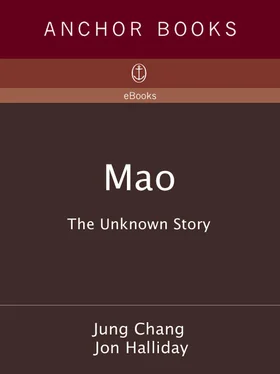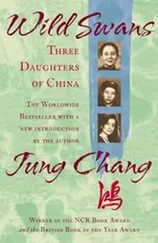Po’s hands, however, were tied. When he left Shanghai, Moscow’s agent Ewert had told him bluntly that he absolutely had to work with Mao. But this injunction did not extend to Mao’s followers, and here Po took action. From February 1933 on, a string of Mao’s acolytes — all low-level, including Mao’s brother Tse-tan — was criticized in the press, though only the top few knew that Mao was the real target, and his reputation among the rank and file was carefully preserved. Moreover, Po did not use Mao’s killer methods. Although the language was high-decibel (“smash into smithereens,” “cruelly struggle”), Mao’s followers were treated as comrades who had erred, not as “enemies,” and some were allowed to retain important posts.
Po Ku was able to dismantle Mao’s separate chain of command, and unite the Party to fight Chiang, with great success. For the first time, the Red Army defeated the Generalissimo’s crack troops in battles involving tens of thousands of men. Chiang’s latest annihilation expedition folded in March 1933.
DURING THIS FOURTH campaign, Chiang had to fight the Reds against the background of a deepening national crisis. In February 1933 the Japanese had thrust out of Manchuria across the Great Wall into north China proper, threatening Peking. That same month the Japanese set up a puppet state called Manchukuo in the northeast.
Ruijin also won this fourth campaign thanks to great help from the Soviet Union, which had just restored diplomatic relations with Chiang, in December 1932. Restoring formal ties allowed Russia to get more intelligence officers back into China under diplomatic and press cover, to help the Chinese Communists. The Russian military attaché, GRU Major-General Eduard Lepin, played a central role, as he regularly saw Chiang and top Nationalist officers, and could pass high-level up-to-date information to the Chinese Red Army, also acting as liaison between it and the military advisory group for the CCP in Moscow. Moscow’s secret military advisers in China also had a big hand in the war. When Mao later met one of them, the German Communist Otto Braun (the only one who got through to Ruijin), Mao paid him a compliment. After Mao greeted him “with stiff formality,” Braun recorded, “Mao acknowledg[ed] the successful counter-offensive … in the winter of 1932–33. He said he knew that the impetus for it came from me …”
The main military figure on the Chinese Red side during this fourth campaign was Chou En-lai, and the fact that the Reds were winning unprecedented victories under his leadership greatly boosted Chou’s status and confidence. Mao knew that Moscow recognized winners, and Chou’s military triumph could well tip Moscow in Chou’s favor — especially as Mao had opposed Moscow’s war strategy in the first place. So in February 1933 Mao moved back to Ruijin from his “convalescence,” and started to be cooperative. Moscow continued to accord him unique care and attention, repeatedly admonishing his colleagues that they “must incorporate Mao in work at all cost … Regarding Mao Tse-tung, you must try your utmost to adopt an attitude of tolerance and conciliation …”
Mao went on taking part in top meetings and chairing those to which his post entitled him. He was kept fully briefed and retained his elite privileges. But he knew that Moscow had reservations about him — not least from the way that his acolytes were denounced in the Red newspapers. He could also read the strength of the wind that was blowing against him in the startling degree of his own isolation. Hardly anyone came to visit him. His followers avoided him. Sometimes, his wife recalled, he did not exchange a word with anyone outside his family for days. Mao was to say decades later that it was as if he had been “soaked in a piss barrel, and been sloshed up and down several times, so I really stank.”
A further indication of the way he had slipped in Moscow’s favor came early in 1934, when he lost his position as “premier”—while retaining the grander one of “president.” The main duty of the premier was to run the administration, which Mao could not be bothered to do; and the Party wanted someone in the post who would actually do the job. An ambitious thirty-four-year-old called Lo Fu, who had been trained in Russia, took his place. Mao was compensated by being made a full member of the Politburo for the first time since 1923, but he did not get into the inner core of the Party, the Secretariat. He was not on the list approved by Moscow. Mao boycotted the Party plenum that implemented these decisions, claiming illness. Another “diplomatic disorder,” Po Ku remarked, but let him be.
Mao was still given a high profile and maximum exposure in CCP and Moscow publications. To the population in the Red area — and to the outside world, including the Nationalists — Mao was still “the Chairman.” But in private, Po Ku compared him to Russia’s figurehead president. “Old Mao is going to be just a Kalinin now,” he told a friend. “Ha, ha!”
On 15 April the Communists issued a “declaration of war on Japan.” This was a pure propaganda stunt, and it was more than five years before the Red Army fired a shot at the Japanese (except in Manchuria, where the Party organization came under the control of Moscow, not Ruijin) — making this one of the longest “phoney wars” in history. In fact, the CCP’s proclamation was more a declaration of war on Chiang Kai-shek than on Japan, as it asserted that “in order to … fight the Japanese imperialists, it is necessary first of all to overthrow the rule of the Nationalists.” In secret intra-CCP communications, there was not a single reference to Japan as the enemy.
†The mutineers belonged to a unit of 17,000 men whose commander had brought them over to the Reds from Ningdu in December 1931. This was the only mutiny in the Communists’ favor since Nanchang in 1927—and for many years to come. These newcomers increased the Red Army’s strength in the Fujian — Jiangxi theater by one-third, to over 50,000 men. Their commander, Ji Zhen-tong, quickly realized what he had let himself and his army in for, and asked “to go to the Soviet Union for studies”—the only pretext he could give to get away. He was soon arrested, and later executed.
The Party was no longer able to operate underground in any city in the White areas, as a result of effective Nationalist policing plus massive defections. In history books this failure is blamed, unfairly, on Li Li-san, the all-purpose scapegoat.
Apart from Japan, the only states that recognized it were El Salvador, the Vatican and the Soviet Union, where the Manchukuo flag flew over consulates at Chita and Vladivostok. This was part of an attempt by Stalin to appease Tokyo, to try to prevent it turning north to attack the Soviet Union.
11. HOW MAO GOT ONTO THE LONG MARCH (1933–34 AGE 39–40)
IN SEPTEMBER 1933, Chiang Kai-shek mobilized half a million troops for yet another “annihilation expedition”—his fifth — against the Ruijin base. In May he had agreed to a truce with the Japanese, acquiescing to their seizure of parts of north China, in addition to Manchuria, and this freed him to concentrate in strength against the Reds.
Over the previous months Chiang had been building solid roads that enabled his troops to mass in the area and bring up supplies. With this logistic preparation, Chiang was now able to close in on the Red area. The armies then pushed into the Red base slowly, pausing every couple of kilometers to construct small forts that stood so close together they could virtually be connected by machine-gun fire. The Reds were tightly encircled by these blockhouses. As their commander, Peng De-huai, described it, Chiang was forcing the Red area “to shrink gradually: the tactics of drying the pond and then getting the fish.”
Читать дальше










